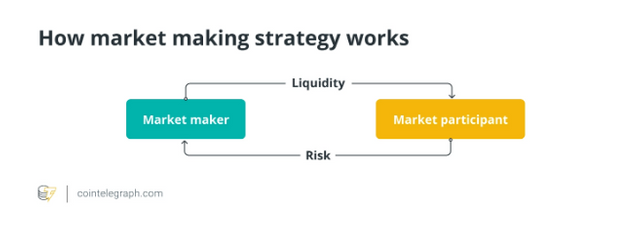How does high-frequency trading work on decentralized exchanges?
High-recurrence exchanging permits digital money merchants to make the most of market open doors that are typically inaccessible to customary brokers.
Following the decentralized money (DeFi) blast of 2020, decentralized trades (DEXs) cemented their position in the environments of both digital currency and money. Since DEXs are not so vigorously directed as concentrated trades, clients can list any symbolic they need.
With DEXs, high-recurrence merchants can make exchanges on coins before they hit significant trades. Also, decentralized trades are noncustodial, which suggests that makers can't pull a leave extortion — in principle.
Accordingly, high recurrence exchanging firms that used to handle novel exchanging exchanges with cryptographic money trade administrators have gone to decentralized trades to
What is high recurrence exchanging crypto?
High recurrence exchanging (HFT) is an exchanging strategy that utilizes complex calculations to dissect a lot of information and make fast exchanges. All things considered, HFT can examine various business sectors and execute a huge volume of orders in no time. In the domain of exchanging, quick execution is in many cases the way to creating a gain.
HFT dispenses with little bid-request spreads by making enormous volumes from exchanges quickly. It additionally permits market members to exploit cost changes before they are completely reflected in the request book. Therefore, HFT can create benefits even in unstable or illiquid markets.
HFT previously arose in conventional monetary business sectors yet has since advanced into the digital currency space attributable to infrastructural upgrades in crypto trades. In the realm of cryptographic money, HFT can be utilized to exchange on DEXs. It is now being utilized by a few high recurrence exchanging houses, for example, Hop Exchanging, DRW, DV Exchanging and Hehmeyer, the Monetary Times revealed.
Decentralized trades are turning out to be progressively well known. They offer many benefits over conventional concentrated trades (CEXs), like better security and protection. In that capacity, the rise of HFT techniques in crypto is a characteristic turn of events.
HFTs' prominence has likewise brought about some crypto exchanging centered mutual funds utilizing algorithmic exchanging to create huge returns, provoking pundits to denounce HFTs for giving bigger associations an edge in crypto exchanging.
Anyway, HFT gives off an impression of being staying put in the realm of digital money exchanging. With the right foundation set up, HFT can be utilized to create benefits by exploiting great economic situations in an unpredictable market.
How does high recurrence exchange work on decentralized trades?
The fundamental rule behind HFT is straightforward: purchase low, sell high. To do this, HFT calculations investigate a lot of information to distinguish examples and patterns that can be taken advantage of for benefit. For instance, a calculation could distinguish a specific value pattern and afterward execute countless trade orders with hardly a pause in between to exploit it.
The US Protections and Trade Commission doesn't utilize a particular meaning of high recurrence exchanging. Be that as it may, it records five principal parts of HFT:
Utilizing rapid and complex projects to produce and execute orders
Diminishing possible postponements and latencies in the information stream by utilizing colocation administrations presented by trades and different administrations
Utilizing brief periods of time to open and close positions
Presenting different orders and afterward dropping them soon after accommodation
Diminishing openness to expedite risk by standing firm on footholds for extremely brief periods
More or less, HFT utilizes refined calculations to break down all digital forms of money across different trades at exceptionally high velocities ceaselessly. The speed at which HFT calculations work gives them a critical benefit over human dealers. They can likewise exchange on various trades all the while and across various resource classes, making them exceptionally flexible.
HFT calculations are worked to recognize exchanging triggers and patterns not effectively detectable to the unaided eye, particularly at speeds expected to at the same time open countless positions. Eventually, the objective with HFT is to be the preferred choice when recent fads are recognized by the calculation.
After an enormous financial backer opens a long or short situation on a cryptographic money, for example, the cost typically moves. HFT calculations exploit these resulting cost developments by exchanging the other way, rapidly reserving a benefit.
All things considered; enormous cryptographic money deals are ordinarily unsafe to the market since they for the most part drag costs down. Nonetheless, when the digital money bounce back to typical, the calculations "purchase the plunge" and leave the positions, permitting the HFT firm or merchant to benefit from the cost development.
HFT in cryptographic money is made conceivable in light of the fact that most advanced resources are exchanged on decentralized trades. These trades don't have similar incorporated framework as customary trades, and thus, they can offer a lot quicker exchanging speed. This is great for HFT, as it requires split-second independent direction and execution. As a general rule, high-recurrence brokers execute various exchanges each second to collect unobtrusive benefits over the long run and create a huge benefit.
What are the top HFT methodologies?
Despite the fact that there are an excessive number of kinds of HFT techniques to show, some of them have been around for some time and aren't new to experienced financial backers. The possibility of HFT is habitually associated with customary exchanging procedures that exploit state of the art IT capacities. Be that as it may, the term HFT can likewise allude to additional crucial approaches to making the most of chances on the lookout.
Related: Crypto exchanging rudiments: A novice's manual for digital currency request types
Momentarily put, HFT might be viewed as a technique in itself. Subsequently, rather than zeroing in on HFT in general, breaking down specific exchanging strategies that utilize HFT technologies is significant.
Crypto exchange
Crypto exchange is the most common way of creating a gain by exploiting cost contrasts for similar digital currency on various trades. For instance, on the off chance that one Bitcoin (BTC) costs $30,050 on Trade An and $30,100 on Trade B, one could get it on the principal trade and afterward promptly sell it on the second trade for an easy gain.
Crypto brokers who benefit from these market irregularities are called arbitrageurs. Utilizing effective HFT calculations, they can exploit inconsistencies before any other individual. In doing as such, they assist with settling markets by adjusting costs.
HFT is profoundly gainful to arbitrageurs in light of the fact that the open door for directing exchange techniques is generally tiny (under a second). To quickly take advantage of momentary market chances, HFTs depend on powerful PC frameworks that can filter the business sectors rapidly. Moreover, HFT stages find exchange open doors as well as make exchanges up to many times quicker than a human dealer.
Market making
Another normal HFT system is market making. This includes putting in trade requests for a security simultaneously and benefitting from the bid-ask spread — the contrast between the cost you're willing to pay for a resource (ask cost) and the cost at which you're willing to sell it (bid cost).
Enormous organizations called market creators give liquidity and great request in a market and are notable in regular exchanging. Market creators can likewise be connected to a cryptographic money trade to ensure market quality. Then again, market creators that have no concurrences with trade stages additionally exist — their point is to utilize their calculations and benefit from the spread.
Crypto dealers who benefit from these market irregularities are called arbitrageurs. Utilizing effective HFT calculations, they can exploit disparities before any other person. In doing as such, they assist with settling markets by adjusting costs.
HFT is exceptionally helpful to arbitrageurs in light of the fact that the open door for directing exchange techniques is generally tiny (under a second). To quickly jump all over transient market chances, HFTs depend on hearty PC frameworks that can examine the business sectors rapidly. What's more, HFT stages find exchange open doors as well as make exchanges up to many times quicker than a human dealer.
News by: cointelegrapg
Join free Giveaway'🤑🤑
Have a chance to win $750 free paypal gift card
Join now: https://tinyurl.com/freegiftcard090
.png)
.png)
.png)
